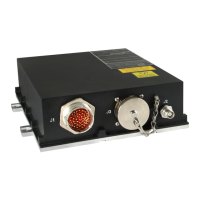INSTALLATION MANUAL
CMA-5024 GLSSU
This document includes Proprietary Information and shall not be reproduced or communicated to third party
without prior written permission by CMC Electronics Inc.
Page 20
November 21, 2008
- A high-speed digital signal processor. By means of digital correlation processes, the device de-
spreads the wideband C/A code modulation of the GPS/SBAS satellite signals to convert them to
low-speed digital signals. The device implements 24 parallel Narrow Correlator ®
1
code-tracking
channels using a nominal Early/Late correlators spacing of 1/10 C/A code chips (0.1 usec).
- A general-purpose 64-bits data CPU and its data memories. The device computes ten times per
second a PVT solution, using the data from the digital signal processor.
The CRA includes the following digital I/O interfaces; refer to Appendices A and C for a detailed
description of the I/O:
- A set of 16 input and 10 output ARINC-429/419 serial data busses for avionics interfaces. These
busses are fully independent and include output read-backs for fault detection.
- A set of 3 analog ARINC-743A time-mark pulse outputs, driven from a common time-mark signal,
which allow precise time-distribution to the aircraft systems for purpose of synchronization to
Universal Time Coordinated (UTC).
- Seventeen discrete data inputs.
- Six discrete data outputs.
- A factory maintenance bus (RS-232 port), BITE and integrity monitoring functions. This includes
processor watchdog circuits and data wrap-around test circuits for verifying the health of the
input/output interfaces.
J. High Integrity Switch (HIS) Description
The HIS switch built-in the CRA is described summarily below. Refer to the installation block-diagram
in Figure 8:
(1) The HIS is a high-integrity digital data hardware switch / software router that operates on the
ARINC-429 data input/output busses carrying the DME/ILS data. A redundant power input (28 V
HIS Input & Return at approach connector Pins J3-1 and J3-2) may be used to power the HIS.
(2) A discrete signal input (ILS/GLS Source Select, at approach connector Pin J3-18) determines which
flight deviation data source (DME/ILS or GLS) the HIS must use. The HIS operates as follows:
- For conventional ILS approaches, the HIS passes through transparently the DME/ILS data
using only the high integrity hardware switch, and with a latency of 0.5 microseconds maximum.
- For SBAS approaches, the HIS substitutes on-the-fly the internal DME/ILS Look-alike deviation
data computed by the GLSSU to the original DME/ILS deviation data, using the built-in data
router.
1
Registered trademark from Novatel, Calgary, Alberta, Canada
The document reference is online, please check the correspondence between the online documentation and the printed version.

